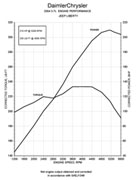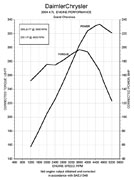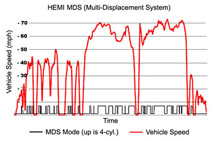|
WK engine features
3.0-liter Turbo Diesel (2007-2008*)
215 hp / 376 lb-ft torque
The 3.0-liter V-6 “common rail” direct injection engine is a 72°, overhead valve design. The engine utilize a cast aluminum cylinder block molded around cast iron piston sleeves. The engine has aluminum cross flow cylinder heads, four valves per cylinder, central injectors and dual overhead camshafts. The 3.0L is turbocharged, intercooled, and also equipped with a EGR cooler.
Additional features are:
Finger Follower Actuated Valves with Hydraulic Adjusters
Counter Rotating Balance Shaft
Oil Jet Cooled Pistons
Swirl Intake Ports
Chain driven D.O.H.C. per bank of cylinders, with 4 valves per cylinder
*2007, 2008 and 2008.5 model years only. Production of this engine ended in November 2008.
3.7-liter V6 (2005-2010)
210 hp / 235 lb-ft torque
The 3.7-liter V-6 engine provides the 2005 Jeep Grand Cherokee with an efficient, durable and smooth base engine. It produces 210 hp (157 kW) @5200 rpm and 235 lb-ft (319 N•m) @4000 rpm. The 3.7-liter SOHC V-6 will replace and deliver even more peak power than the previous 4.0-liter I-6 in the Jeep Grand Cherokee lineup. The engine was first introduced in the Jeep Liberty and has been continuously refined to provide smooth V-6 power with optimal economy.
Significant changes in the 3.7-liter include a revised cam profile and new valve lash adjusters. These changes improve the engine smoothness at idle. To ensure quiet operation, a new thick-wall composite manifold is new for 2005, as are structural improvements to the air box and resonator. The cylinder head has been redesigned, increasing the compression ratio to 9.7:1. The 3.7-liter now uses plastic cylinder head covers.
4.7-liter V8 (2005-2007)
235 hp / 290 lb-ft torque
The 4.7-liter V-8 was updated for the 2005 model year and was the mid-range engine in 2005-2007 model Grand Cherokees. The engine produces 235 hp (172 kW) @ 4700 rpm and 290 lb-ft (393 N•m) of torque @ 3700. Dual knock sensors have been added for 2005 and enable improved engine calibration for both fuel economy and power output. The updated engine has improved NVH characteristics, realized through the use of composite valve covers, structural improvements to the air box and resonator and improved dampening of the heat shields. An EGR valve is now used to reduce NOX emissions while improving fuel economy by replacing some of the incoming fuel/air mixture with inert exhaust gas.
The Dana corporation supplied the new reduced-tension piston rings and the rod bearings. Dana also supplied the new cylinder-head, cam-cover module. The new thermoset plastic cylinder-head cover module was developed in just 12 months and replaces a magnesium component. Due to innovative manufacturing processes, Dana was able to reduce the overall cost of the module, while incrementally improving noise, vibration, and harshness, or NVH.
The vinyl ester glass-reinforced thermoset plastic modules, which are unique to the left- and right-side cylinders, include the cover, gasket, and fasteners. These components are produced at Dana's Composite Sealing Center in Paris, Tenn. With this new sealing system, Dana developed a custom compound material for gaskets and grommets. Dana also provided prototyping for the gasket and isolator molds to ensure the design met all of Jeep's specifications. The system relies on a self-retaining, "press-in-place" gasket to
improve function and quality consistency. This innovation eliminates the time- consuming and costly steps of precisely aligning and attaching the gasket to the valve cover with adhesive.
Dana engineers worked closely with DaimlerChrysler's technical staff to provide 3-D solid models to fit tight, under-the-hood requirements. Dana also provided material development and component validation to ensure robust system performance. This collaborative effort eliminated the prototype step for the cover housing, which in turn reduced development time and cost by allowing the component to move directly from design to production.
4.7-liter V8 (2008-2009)
305 hp / 334 lb-ft torque
2008 models of the Grand Cherokee and Commander will feature a new updated 4.7-liter V-8. The new engine offers better fuel economy, power, and torque than the previous 4.7-liter engine, while increasing refinement, thanks to dual spark plugs per cylinder, increased compression, better cylinder-head port flow, and a new combustion system. The result is 305 horsepower, a 30 percent increase; and 334 lb.-ft. of torque, a 10 percent increase. The engine is still capable of operating on E85 ethanol fuel. Smoother and quieter running came from revisions to the induction system, a lightweight piston/rod assembly, reduced accessory drive noise through lower accessory drive speed, and a new valve-lash adjuster system. The new 4.7-liter V-8 is also equipped with Electronic Throttle Control.
5.7-liter V8 HEMI (2005-2008)
330 hp / 375 lb-ft torque
The 5.7-Liter V-8 HEMI engine that powers the 2005-2008 Jeep Grand Cherokee uses aluminum cylinder heads with hemispherical combustion chambers, creating outstanding airflow leading to high power and torque. The engine produces 330 hp (246 kW) @5000 rpm and 375 lb-ft (502 N•m) @4000 rpm. Dual ignition (two spark plugs per cylinder) increases peak power and torque, reduces exhaust emissions, increases fuel economy and provides a smooth idle. The combustion system has been refined and the engine uses direct-mount accessories for quieter operation.
“Two legends combine with the introduction of the modern HEMI V-8 in the 2005 Jeep Grand Cherokee,” said Eric Ridenour, Executive Vice President—Product Development. “The HEMI is the most powerful engine ever offered in a Grand Cherokee and easily gives the vehicle best-in-class power.”
Fuel economy has also been improved, but not at the expense of HEMI performance. Chrysler Group has developed the Multi-Displacement System (MDS) that deactivates four cylinders when the V-8 is not needed. The 2005 Grand Cherokee is the first SUV to offer fuel-conserving MDS.
The Chrysler Group MDS seamlessly alternates between smooth and economic four-cylinder mode when less power is needed and V-8 mode when more power from the 5.7-liter HEMI engine is in demand. This optimizes fuel economy when V-8 power is not needed without sacrificing vehicle performance or towing capability.
“The MDS was part of the engine’s original design,” said Bob Lee, Vice President—Powertrain Product Team. “This results in a cylinder deactivation system that is elegantly simple and completely integrated into the engine design. The benefits are fewer parts, maximum reliability and lower cost.”
Some of the significant technologies enabling the MDS are the speed of electronic controls, the sophistication of the algorithms controlling the systems and the use of Electronic Throttle Control. The HEMI is able to transition from eight cylinders to four in 40 milliseconds.
This engine and MDS has completed over 6.5 million customer-equivalent miles through Chrysler Group’s development and durability testing. It is covered by the seven-year/70,000-mile Limited Powertrain warranty.
The HEMI engine that powers the 2005 Jeep Grand Cherokee uses aluminum cylinder heads with hemispherical combustion chambers, creating outstanding airflow leading to high power and torque. Dual ignition (two spark plugs per cylinder) increases peak power and torque, reduces exhaust emissions, increases fuel economy and provides a smooth idle. The combustion system has been refined and the engine uses direct-mount accessories for quieter operation.
Engine components from the 2005-2008 5.7-Liter MDS Hemi engine.
5.7-liter V8 HEMI VVT (2009-2010)
357 hp / 389 lb-ft torque
The all-new 2nd generation 5.7-liter HEMI V-8 engine offers better fuel economy, improved idle quality and overall refinement, along with more horsepower and torque. HEMI has always been synonymous with power, and now - thanks to VVT, expanded four-cylinder mode in the MDS system, and a host of other technologies - Chrysler's new HEMI delivers more fuel efficiency and refinement, along with even more power. Other enhancements include an increased compression ratio and an active intake manifold with long runners for low-end torque and short runners for high-rpm power. The cylinder head port flow efficiency has also been improved.
The HEMI's new VVT improves fuel economy under some conditions in two ways. First, it reduces the engine's pumping work by closing the intake valve later. Second, it increases the expansion process of the combustion event. This allows more work to be transferred to the crankshaft instead of being rejected out of the exhaust port as heat. Essentially, VVT optimizes engine breathing, which improves engine efficiency and power.
The fuel-saving MDS system seamlessly alternates between smooth, high- fuel-economy four-cylinder mode when less power is needed, and V-8 mode when more power from the new 5.7-liter HEMI engine is in demand. An expanded MDS operating range in the new-for-2009 HEMI will allow customers to realize an
even-greater fuel economy benefit. When MDS is operating, it is indicated by the fuel-economy- mode readout in the Electronic Vehicle Information Center.
6.1-liter V8 HEMI (2006-2010)
420 hp / 420 lb-ft torque
The 6.1L-liter V8 HEMI made its Jeep debut in the 2006 Grand Cherokee SRT8 which went on sale in January of 2006. When SRT powertrain engineers set out to develop a more powerful HEMI they were mindful of the engine's heritage, which led to adopting traditional HEMI engine cues including an orange-painted cylinder block and black valve covers. SRT engineers who developed the 6.1L engine achieved more horsepower by adding more cubic inches, increasing the compression ratio, and redesigning the cylinder head, intake and exhaust systems for better flow and increased engine speed.
For more displacement, SRT engineers bored out the diameter of the cylinders in the HEMI by 3.5 millimeters each in order to increase the total displacement to 6.1 liters from 5.7 liters. Compression ratio was also increased to 10.3:1 from 9.6:1, increasing engine efficiency and power. Cylinders are honed with torque plates to ensure a truer bore, to reduce friction and increase power.
Engine breathing was increased with new higher-flow cylinder heads, a specially designed intake manifold, and exhaust headers with individual tubes encased in a stainless steel shell, all unique to the 6.1-liter HEMI engine. Larger-diameter valves and reshaped ports in the heads allow for maximized air flow. The intake manifold was designed with larger diameter and shorter runners for higher-speed tuning. Exhaust runners allow increased gas flow while maintaining fast catalyst light-off, while adding 12 horsepower over the 5.7-liter engine’s cast manifolds. Exhaust is routed through a large diameter (2.75-inch vs. 2.5-inch) exhaust system with 3.5-inch chrome tips.
To further increase horsepower, performance-oriented camshaft profiles were developed to allow more air in and out of the cylinders, as well as manage a higher engine speed. A billet steel, high-strength camshaft features more overlap and lift for better performance. Silent chain, 5-bearings. Bi-metal material except number 3 Babbit. Deep-fillet rolled journals for improved fatigue life, press fit damper to minimize torsional vibration.
SRT engineers increased the HEMI's peak power output engine speed by nearly 20 percent to 6,000 revolutions per minute (rpm) from 5,000 rpm. Intake and exhaust valve stems are hollow, and the exhaust valve stems are filled with sodium to help dissipate heat more efficiently.
The high-performance SRT 6.1-liter HEMI is strengthened with redesigned components, including a reinforced engine block, forged micro-alloy steel crankshaft with retuned damper, high-strength powdered metal connecting rods and floating-pin pistons. The pistons are cooled by oil squirters, aimed at the underside of each piston to aid piston cooling for engine durability. A special oil pump pressure relief valve is added to accommodate the squirter oil flow. The oil pan and windage tray are modified to manage oil return to the pan sump at high engine speeds and improve power.
6.4-liter V8 HEMI (2011-2012 model years)
A 6.4L-liter V8 HEMI with MDS has been approved for production and will debut in SRT8 models of the 2011 Challenger, the 2011 Charger and the 2011 300C. The Jeep Grand Cherokee will also receive this engine in the 2012 model year. The production version of the 6.4 engine is expected to produce anywhere from 470-hp to 510-hp.
| 





